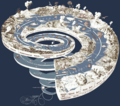Geochronology facts for kids
Geochronology is the science of figuring out how old rocks, fossils, and sediments are. Think of it like being a detective, but instead of solving crimes, you're solving the mystery of Earth's past! Scientists use different methods to find the exact age of these materials. This helps us understand the long history of our planet and the life that has lived on it.
Contents
How Scientists Find Ages
Radiometric Dating: Using Atomic Clocks
Radiometric dating is a powerful way to find the exact age of rocks and other materials. It works by looking at tiny particles called isotopes inside them. Some isotopes are radioactive, meaning they slowly change into other, more stable isotopes over time. This change is called radioactive decay.
Each radioactive isotope decays at a very steady rate, like a tiny clock ticking. This rate is known as its half-life. The half-life is the time it takes for half of the radioactive atoms in a sample to decay. By measuring how much of the original radioactive isotope is left, and how much of the new, stable isotope has formed, scientists can calculate the age of the material.
Different isotopes have different half-lives. This means they are useful for dating different time periods:
- Isotopes that decay slowly are good for dating very old rocks, like those millions or billions of years old.
- Isotopes that decay faster are better for dating younger materials.
Here are some common radiometric dating methods:
- Radiocarbon dating: This method measures the decay of carbon-14 in things that were once alive, like wood, bones, or shells. It's best for samples younger than about 60,000 years. It helps date ancient human sites.
- Uranium-lead dating: This technique looks at the amounts of different lead isotopes that come from decaying uranium. It's often used on tiny minerals like zircon found in igneous rocks. This method is great for very old samples, usually older than 1 million years.
- Uranium-thorium dating: This method is used for dating things like speleothems (cave formations), corals, and fossil bones. It can date samples from a few years old up to about 700,000 years.
- Potassium-argon dating: This method is used to date metamorphic, igneous, and volcanic rocks. It's also useful for dating layers of volcanic ash found at places where early humans lived. This method can date things that are thousands of years old or much, much older.
Cosmogenic Nuclide Dating: Surface Ages
This method helps scientists figure out when a surface, like a rock or a landform, was first exposed to the sky. It works by measuring special isotopes called cosmogenic nuclides. These nuclides are made when cosmic rays from space hit materials on Earth's surface. The longer a surface has been exposed, the more of these nuclides it will have.
This technique can tell us when a river fan was formed or when a glacier melted away, leaving rocks exposed.
Luminescence Dating: Light from the Past
Luminescence dating uses the light that certain materials can give off. Materials like quartz, diamond, and feldspar can store energy from natural radiation over time. When heated or exposed to light, they release this stored energy as light.
The amount of light released tells scientists how long it has been since the material was last exposed to sunlight or heat. This method is often used in archaeology to date pottery, sediments, or ancient tools.
Incremental Dating: Counting Years
Incremental dating methods allow scientists to build a year-by-year timeline. It's like counting rings on a tree!
- Dendrochronology: This is the study of tree rings. Each year, a tree grows a new ring. By counting these rings, scientists can find the exact age of a tree and learn about past climates.
- Ice cores: Scientists drill deep into ice sheets to pull out long cylinders of ice. Each year, a new layer of snow falls and turns into ice. These layers can be counted like tree rings, and they also contain clues about past atmospheres and temperatures.
- Varves: These are layers of sediment that form in lakes, often in areas where glaciers have been. Each pair of light and dark layers represents one year of sediment deposition.
Paleomagnetic Dating: Earth's Magnetic Field
The Earth's magnetic field has changed its direction many times throughout history. When certain rocks form, tiny magnetic particles within them line up with the Earth's magnetic field at that time.
Scientists can study the pattern of magnetism in a rock formation. By comparing this pattern to known changes in Earth's magnetic field over time, they can help figure out when the rock was formed.
Stratigraphy: Layers of Time

Stratigraphy is the study of rock layers, or "strata." Think of it like a giant layer cake, where each layer tells a story about a different time period.
Sometimes, there are special layers called marker horizons. These are layers that are the same age and have a unique look or content, even if they are found in different places. For example:
- Fossil layers: Layers containing specific groups of fossils (like certain ancient animals or plants) can act as marker horizons. If you find the same group of fossils in two different places, you know those rock layers are the same age.
- Volcanic ash (tephra): When a volcanic eruption happens, ash can spread over a huge area. This ash forms a distinct layer. If the date of the volcanic eruption is known, then any rock or archaeological site found above or below that ash layer can be dated more accurately. Scientists can even use the chemical "fingerprint" of the ash to match it to a specific eruption.
Related pages
Images for kids
See also
 In Spanish: Geocronología para niños
In Spanish: Geocronología para niños


